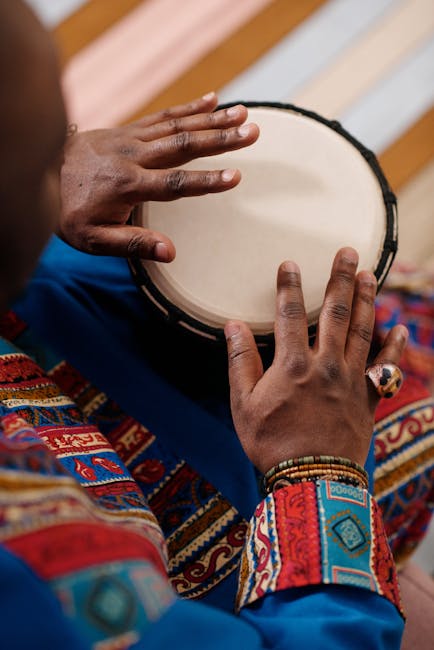(upbeat percussive music) (drumsticks clacking) (drum solo) – Hey, everyone, it's
Jared here, back with the fifth lesson in my Fastest
Way to Get Faster Series, Now, what would a
fastest-way-to-get-faster
series be without some crazy crossovers? That's what we're gonna
be talking about today. Now, before I get
into it, disclaimer: it's really easy to injure
yourself doing crossovers. I've poked myself in the
eye; I've bashed my hands; I've hurt my shoulders,
moving around back and forth. So be very very careful,
go really really slow. The first exercise is
played as 16th notes. We're starting on the floor
tom with the right hand, then we go to the snare
with the left hand, then we go to the hi-hat
with the right hand, and then the floor tom. That pattern just repeats
itself over and over again. The right hand's basically going from the floor
tom to the hi-hat, and the left hand is going from
the snare to the floor tom.
I'll play it nice and slow. (slow drum solo) Let's put it to a metronome
at slow and fast speeds. (drumsticks and
metronome clacking) (drum solo) (drumsticks and
metronome clacking) (uptempo drum solo) The next exercise is also
using a single-stroke roll, but we're just gonna
play 16th-note triplets instead of 16th notes. So nice and slow,
this is how it looks. We start with the floor tom with one stroke
on the right hand. Then, from there on out, we play two on the high
tom, two on the floor tom; two on the high tom,
two on the floor tom. But you always alternate
your stickings. Then we end with just
one single floor tom. So nice and slow. (slow drum solo) Really practice those movements because when you start playing
this at the faster tempos it's really easy
to bash your hand instead of hitting the drum. So be careful and
take it nice and slow.
Here it is, both
slow and fast speeds. (drumsticks and
metronome clacking) (drum solo) (drumsticks and
metronome clacking) (uptempo drum solo) The third exercise might
look a little bit crazy on the sheet music, but
don't worry about it. I have notated it as 32nd notes. If you'd like to play
it as 16th notes, print out the sheet music,
draw a line down the middle, and count it 1-e & ah 2-e
& ah 3-e & ah 4-e for the first bar, and
then 1-e & ah 2-e and a 3-e & ah
4-e for the second bar. You can play it as a
two-bar 16th-note fill or a one-bar 32nd-note fill. The pattern is
actually quite simple. It's just a 10-note pattern
that repeats itself. I wanted to create something
where the right hand crossed over the left and the left
hand crossed over the right.
It does that within
that 10-note grouping. We play this 10-note
grouping three times. 10 times three. I know we don't like
math, but whatever. 10 times three is 30, right? And then we add an
extra two snare strokes at the end before the
pattern resets itself. So let me play it for
you just ultra slow, and you can hear how it sounds. (slow drum solo) Now I'll play it
three times for you, with the two snare
hits at the end. (slow drum solo) And that is the entire pattern. Doesn't sound like much. Probably doesn't
even look like much when it's played at that tempo. But now what I'll do
is I'll play it for you with the metronome at
60 beats per minute and again at 80
beats per minute.

Now, if you can push it
faster, you should try. But, be very very careful;
do not injure yourself. Here we go. (drumsticks and
metronome clacking) (uptempo drum solo) (drumsticks and
metronome clacking) (uptempo drum solo) I play these as
repeating patterns. If you like, you could
just use them as fills. Lemme take the last
one, for example. I'll play a beat, I'll
play it as one-bar fill, then I'll go back to the beat. Here we go. (drumsticks clacking) (drum solo) Really, just practice them
and make them your own. You might find a
different orchestration. You might play the hi-hat
instead of the snare to make the crossovers
more dramatic.
But whatever you do,
just make it your own and make it musical as possible. Don't use this at your next
jazz gig or your next hotel gig where you're supposed
to play very lightly. Use it very very sparingly,
and if you do use it in a place you're
not supposed to, don't tell anyone that I
told you how to do it, OK? (chuckling) So once you can play
them each individually and you've practiced them
for your practice session for five minutes each you
can start playing them in sequenced altogether. (drumsticks and
metronome clacking) (varied-tempo drum solo) And that, my friends,
is the fifth lesson in the Fastest Way to Get Faster
Series on crazy crossovers.
Now get to your kit,
and start practicing. Go! (upbeat percussive music).
from WordPress https://ift.tt/3ArBaPM
via IFTTT

No comments:
Post a Comment